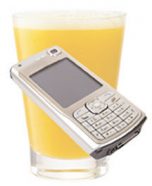Sugar power for cell phones
New technology could lead to cell phones that are powered by sweet drinks.
By Emily Sohn
Drinking sugary soda gives you a burst of energy. Some day, sugar might power electronic equipment as well.
That’s because scientists have now found a way to turn sugar into electricity. If they can find a way to make the technology work on a large scale, you may some day share your sweet drinks with your handheld video game player or cell phone.
 |
|
A new technological advance could lead to cell phones that are powered by sweet drinks.
|
| iStockphoto |
The new strategy involves fuel cells, which are devices that use chemical reactions to produce electrical currents. Manufacturers already make fuel cells that depend on precious metals, such as platinum, to spark those chemical reactions. Precious metals, however, are expensive and hard to get.
For the new study, researchers from St. Louis University used a type of protein called enzymes in place of the metals. In the cells of living things, including people, enzymes are what spark chemical reactions. To keep up the pace that our bodies demand, our cells constantly produce new enzymes as the old ones break down.
Scientists had tried using enzymes in fuel cells before, but they had trouble keeping the electricity flowing. That’s because, unlike the enzymes in our cells, the enzymes in fuel cells break down faster than they can be replaced.
To get around this problem, the St. Louis researchers invented molecules that wrap around an enzyme and protect it. Inside this molecular pocket, an enzyme can last for months instead of days.
In the new fuel cells, electricity-conducting materials are attached to wires. The scientists coat each conductor with a layer of wrapped enzymes. Then, they allow a sugary liquid to ooze inside the enzyme pockets.
When the enzymes interact with the sugar molecules in the liquid, chemical reactions release a flow of electrons into the wire. This process produces both water and an electrical current that could power electronic devices.
So far, the new fuel cells don’t produce much power, but the fact that they work at all is exciting, says Paul Kenis, a chemical engineer at the University of Illinois at Urbana-Champaign.
“Just getting it to work,” Kenis says, “is a major accomplishment.”
Sugar-eating fuel cells could be an efficient way to make electricity. Sugar is easy to find. And the new fuel cells that run on it are biodegradable, so the technology wouldn’t hurt the environment.
The scientists are now trying to use different enzymes that will get more power from sugar molecules. They predict that popular products may be using the new technology in as little as 3 years.—E. Sohn
Going Deeper:
Castelvecchi, Davide. 2007. Is your phone out of juice? Biological fuel cell turns drinks into power. Science News 171(March 31):197. Available at http://sciencenews.org/articles/20070331/fob6.asp .
Sohn, Emily. 2005. Electric backpack. Science News for Kids (Oct. 5). Available at http://sciencenewsforkids.org/articles/20051005/Note3.asp .







